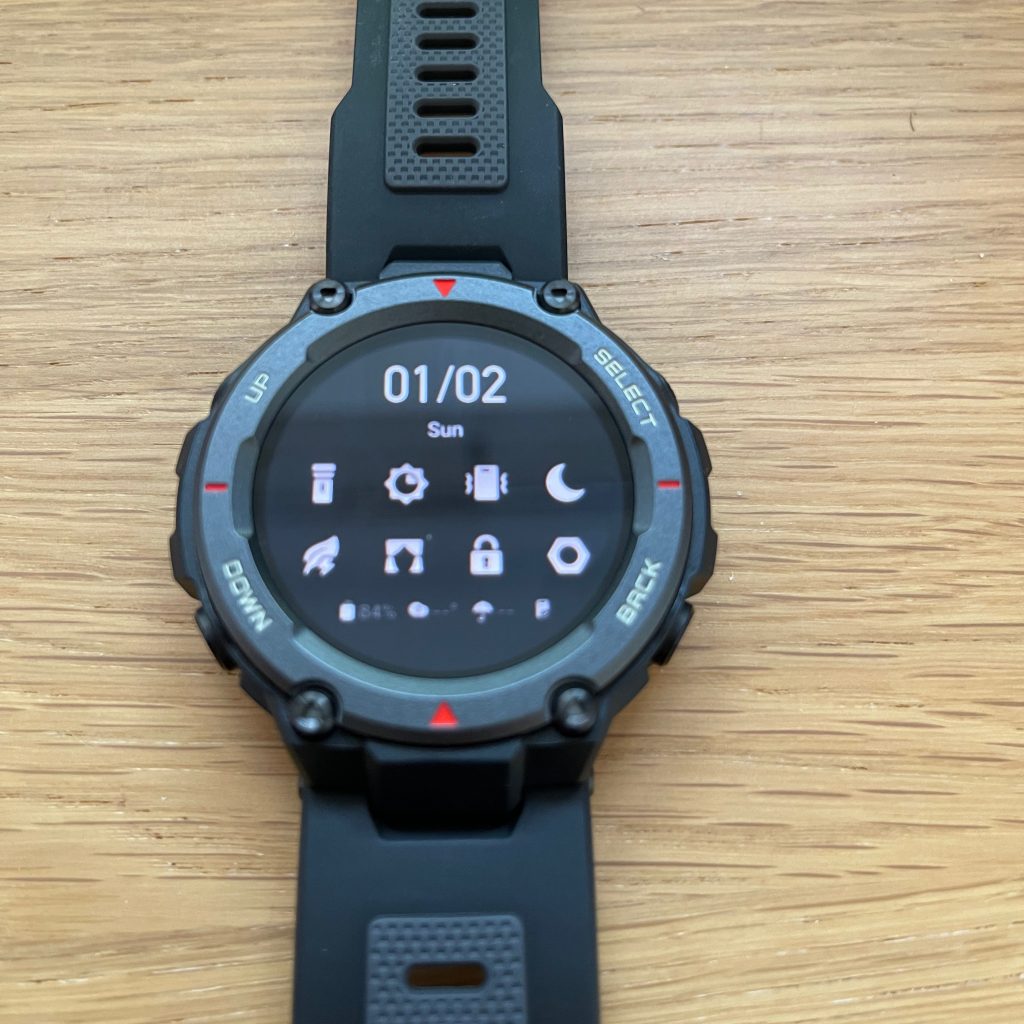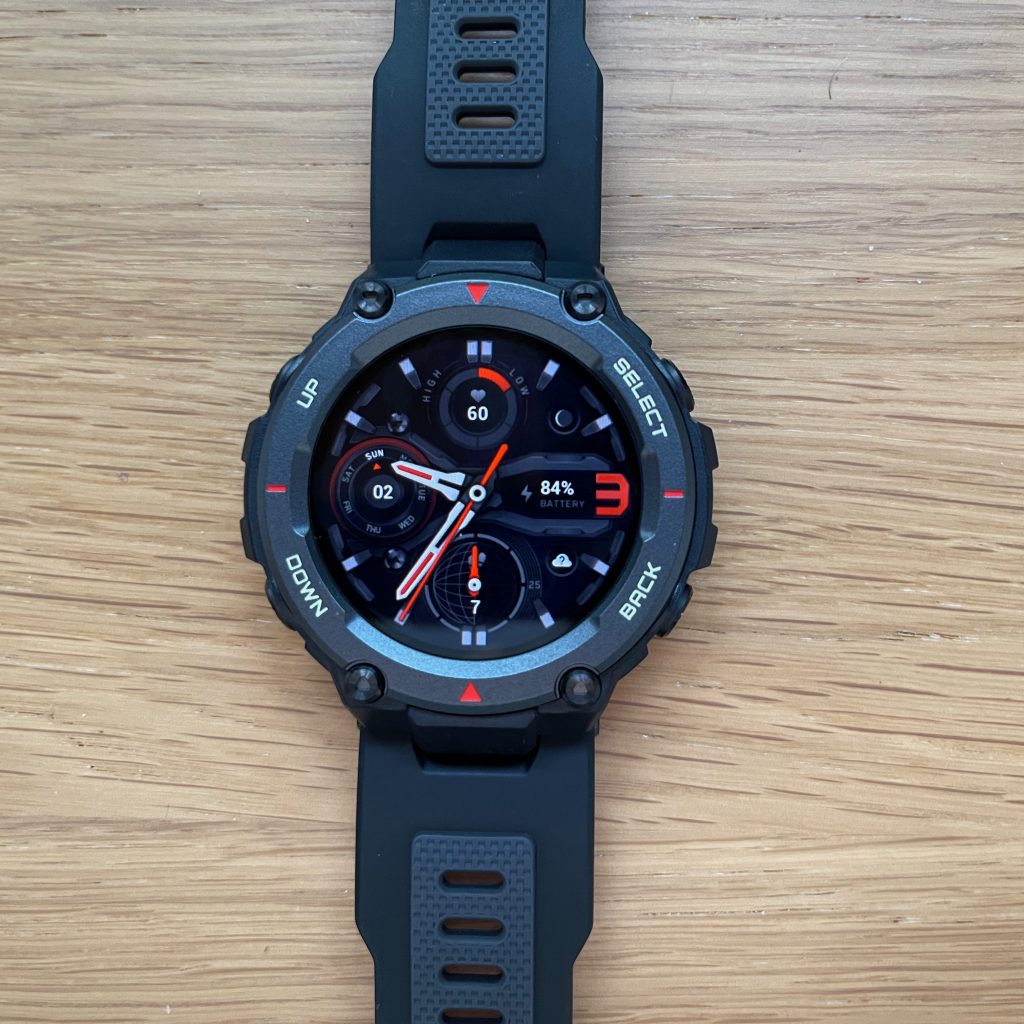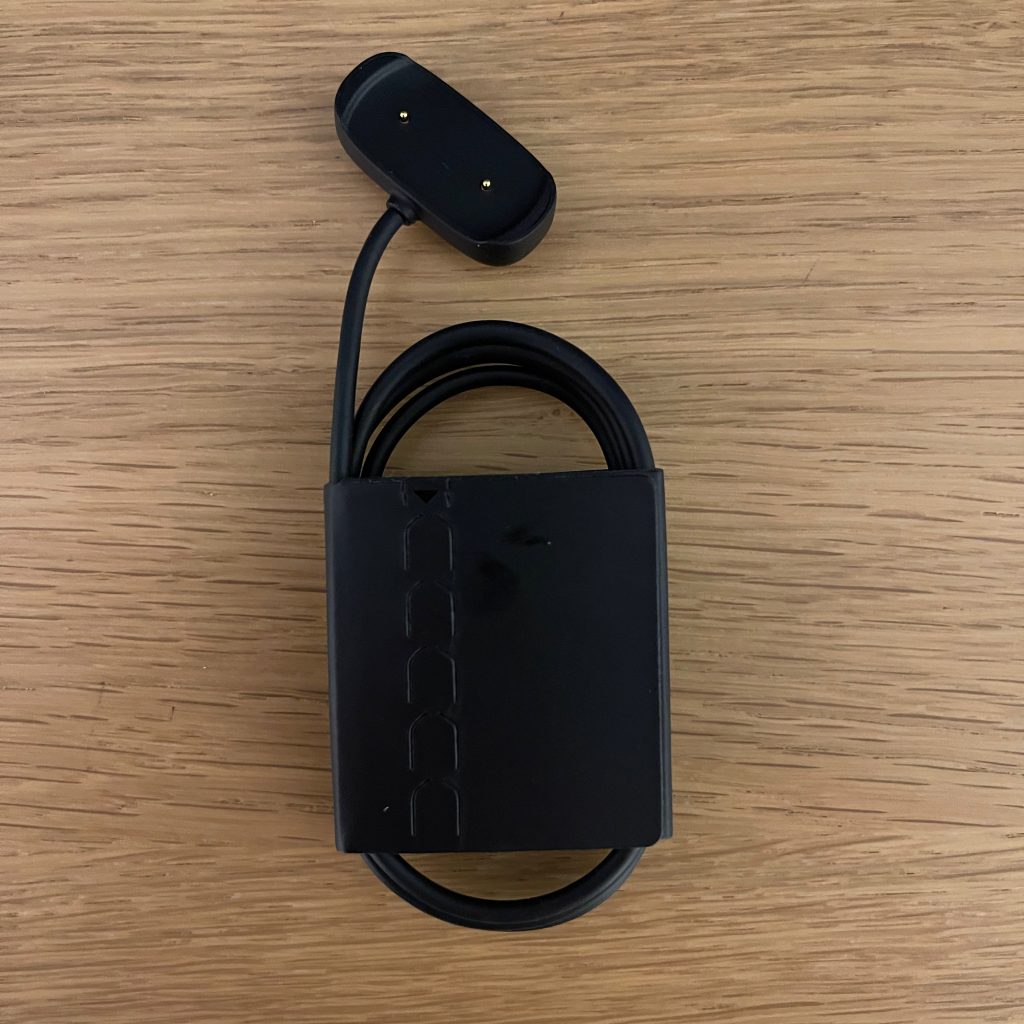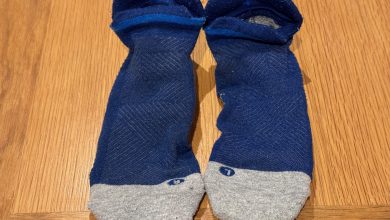Amazfit T-Rex Pro GPS watch review
Intro
Yeah, that headline was a bit a mouthful, in part because I don’t know how to pronounce the manufacturer’s name. Is it ‘amaze’, or ‘ama’, like the Amazon river (and that sizeable retailer birthed by Bezos)? I guess that’s less important than an actual review.
Let’s take a look at the Amazfit T-Rex Pro and see if the hype we’ve been hearing is real.
Jake and I have reviewed quite a few watches and we find it hard to select what some people might consider the best GPS watch (though we have come up with a few ideas here). After all, we all have personal preferences most of which tend to be on the more expensive range of the scale (Jake is still raving about his Tactix Delta, so it must be good). We also recognise gear doen’t have to be expensive to be useful, and that some people don’t want to pay near-extortionate prices to get their hands on a decent hiking, or running, watch.
So we did a little research, dug into pool of low cost GPS watches and discovered Amazfit.
Rather than give you their life story, I’ve added a link to the Amazfit about page at the bottom of this review.
Why choose the Amazfit T-Rex Pro?
For most people looking at this watch, cost is a big consideration. The T-Rex Pro is not expensive. Brand new, you can expect to pay about £139 ($139) which you’ll soon see is a good price for what this sports watch has to offer.
There’s a lot going on inside this watch. I’m not going to detail every function as this would soon turn into one of those epic 15,000 word posts that nobody reads, but lots of people link to. Hmm…
Build and appearance
When I first unboxed this watch I thrown into a timewap that took me all way back to my days in the Army. Back then I owned a Casio G-Shock, which was pretty much bulletproof. That watch took everything I could throw at it and carried on working without once complaining, or falling apart.
The key difference between the two is the weight with the G-Shock weghing a huge 101 grammes and the T-Rex Pro coming in at a paltry 60 g. It’s like comparing a bantam weight boxer with a superheavy weight. This did surprise me as the T-Rex Pro is chunky and I was expecting it to be packing some weight.
When I first got my hands on the watch I couldn’t help thiking if felt flimsy. The light weight added to this feeling, but I have worn it for a couple of weeks and used in on a few runs and, to be honest, it’s a rugged device. Don’t be fooled by looks and weight.
Four chunky, non-slip buttons are to access and navigate the menu system. What I really like is they can be pressed with ease even when you’re wearing a thick pair of gloves, or if you have huge fat fingers like me! For me, the only feature missing from the buttons is the hefty ‘click’ you feel vibrate through your fingertip when you press the butttons on a device like the Fenix 6 (more on that watch here).
The bezel is held in place by four recessed screws. Bit bugbear of mine – having a watch that snags on the cuff of my jacket. Snagging can tear stitching which leads to the eventual disintegration of your favourite hiking jacket. And that will be a very sad day.
Watch Screen
I decided to cover the screen as a separate topic. I’ve never been a fan of touchsceen watches and really didn’t know the T-Rex had this feature. Okay, I’ll be honest and say I simply didn’t read the T-Rex Pro specifications as the desire to get my hands on the watch and test it had me pressing the Amazon ‘Buy now’ button faster than you can say ‘Stop, don’t be a damned fool… read the description…’
Here’s my admission: I like the touchscreen. A lot.
It’s very responsive and the swipe let/right/down functions are pretty cool. Most owners of touchscreen watches are probably laughing at my naiviety right now, but give me a break – I’m a touchscreen newb/convert!
The T-Rex Pro has a 1.3 inch AMOLED screen. A few years back there seemed to many arguments over which was better: AMOLED or Retina. To be honest, I don’t care as they both do what they say on the tin.
One thing you will notice about the widget graphics is they look a little retro… you know, not as pretty or refined as those found more expensive models. But don’t let that put you off this watch. Once you press on a widget, or click using the buttons, you’ll find a very easy on the eye display hidden underneath.
I really like the display on the Fenix 6, but I have to say the bright colours on the T-Rex make the various graphics very easy to read.
Moving on…
By swiping right you can access messages on your phone (I have none… nobody loves me!) Swipe left and you’re plummeted into the heart of the fitness menu system when you can access features such as the GPS, weather alerts, Heart Rate Monitor, barometer and the settings options.
Swipe up for access to a series of graphs showing functions previous activities, your heart rate across the day, number of steps walked each day and more. Press your finger to the screen and draw down to access night mode, screen brightness, and another submenu offering even more configurations. On this menu you’ll find a series of icons looks this:

Press the second in from the right on the top row and a tone will play on your phone. Pretty handy if you’re like me and can rarely remember where you left your handset!
Watch faces
Warning: the default watch face is UGLY!
But there is good news…
For too long the ability to change the face of a sports watch was an option only available on devices that cost more than heart surgery (which you’ll need when you see the price tags on some of the top end models)! In recent years, manufacturers of more affordable offerings coming onto market have picked up on customer demand. Both Google Play and the Apple App Store are creammed full of apps that can be used to change the T-Rex Pro’s face to meet pretty much anyone’s desires.
In fact, one app available for iOS features an insance 43,000 different faces for the T-Rex. I don’t about you, but I’d wouldn’t have the time to sift through all the possible options and test them. Then again, I’m sure someone will and if you do please let us know which youthink is the best option. Here’s a few to whet your whistle.
Before we move on, this is the default face your eyes will be forced to endure when you first power on this T-Rex Pro…

I did warn you!
Widgets on the T-Rex Pro
Lots. The T-Rex Pro has lots of widgets that allow you configure the watch in pretty much any way you see fit. No big deal there, apart from one that’s a little more intereating: PAI, which means Personal Activity Intelligence. At it’s most basic, this is simply a step counter, but with some added science bolted i.
According to researchers, a consistently high PAI will add years to your life. Which is pretty appealing for many people. I do have one tip: don’t spend your time glued to the screen, obsessing about PAI… those buses really do lay in wait.
How well does the T-Rex Pro manage activities?
Before we delve into specifics, there are a ridiculous number of sports activities you can track using this watch. The obvious ones – running, hiking, cycling, etc – are at the top of the menu, but when you scroll further down you find some ‘interesting’ options… like surfing (sorry surfers, I know those big waves get your heart pumping, but it’s not real exercise!)
Running
There are three running options available:
- outdoor running
- treadmill
- trail running.
I understand the differences between running outside and on a maching in a gym, but giving trail running a specific menu option doesn’t make sense. I run. A lot. Most of my routes are cross-country with an average of 30% on roads and trails yet I’ve never found the need to differentiate between the two
Grumble over.
What I will say is the GPS is very accurate. I wore both my Fenix and this watch side by side on a 7km and, despite a very small variance between the two, the T-Trex tracking was near spot on.
One minor point – the T-Rex Pro seemed to take some time to ‘warm up’. For the first four kilometres of the run the watch was between 200 – 300m ahead of the Fenix, settling down to near-parity in the last kilometre. Very odd.
Hiking
It’s not often I say this, but I’m a little confused. Like the running modes, there are a number of options you can choose from. They are:
- hiking
- walking
- indoor walking
- race walking
- treadmill
I get it. Well, part of it. The indoor walking and treadmill modes work independent of the GPS, tracking your heart rate and number of steps. Having other features that pretty much overlap doesn’t make sense.
Race walking, walking and hiking are the same form of exercise albeit at t different speeds. Having so many options doesn’t make sense to me and if I were head of design I’d cut this down to indoor and outdoor modes.
Note: I did notice the updating and displaying of data can be a little slow at times, but who really needs their complete stats within a few seconds of completing a workout?
Durability and comfort
Looks like the old Casio G-Shock, which I owned back when I was serving in the Army (back in those days of pre-history, a time when a GPS weighed the equivalent of a medium-sized cow). I loved my G-Shock. In an act of ‘attraction transference’ I’ve shifted my love to the T-Rex. Not completely, but there’s a definitive feeling of heady nostalgia when I fasten the strap of this watch.
I haven’t owned the watch long enough to confidently comment on the overall durability. Instead, I’ve borrowed some words from Android foruum (that’s not a typo):
The 22mm silicone band that comes with the Amazfit T-Rex Pro is really comfortable. Its dual-texture design offers plenty of clasp points, and it has channels on the underside to help with breathability and allowing moisture to escape.
http://android-foruum.blogspot.com/2021/04/review-amazfit-t-rex-pro-is-so-close-to.html
… Glowing praise, I think you’ll agree. You know, just looking at this watch gives me a warm feeling and I’m sure it will be able to cope with the knocks that will inevitably come whilst out on the tracks and trails.
Fitness tracking
I haven’t had the misfortune joy of owning the original T-Rex, although, Simon, one of my running friends did (for a short time – he sent it back). Enough said. However he did pause long enough to browse the Pro and give me his verdict.
From the horses mouth: there are plenty of new sensors that make this device stand head and shoulders above the predecessor. Location tracking seems to be far more accurate likely due to the expanded GPS support. The SpO2 feature was a long time coming as it’s one found on most other smart watches and I’ve always found it useful for tracking my anerobic training. The altimeter seems like a logical and useful addition when you consider the expanded training modes available in the menu.
Yeah, it looks like a massive leap forward from the last model which, to be honest, was a f… (Simon became inaudible at this point!).
I’d like to add a note about readability. The various graphs give you pletny of data, but yuou’re best off using the Zepp app to be able to interpret them.
And whilst we’re talking about Zepp; my only irritation with the initial setup of the watch is it needs to be paired with the app to enable setup. That’s really annoying for anyone not wanting to link the watch to their phone.
Battery life

Before we delve into battery life, you’ll be really anoyed to hear the T-Rex Pro has a proprietary charging connector. Yes, I can champagne cork popping as you celebrate the need to have yet another cable dangling from the wall socket, one amognst 15 others.
I wish manufacturers would settle on one format. It’s not hard and having a universal connector would go quite some way to reduce the manufacturing waste and emmissions that come churning out so many cables.
Hmm, that’s ironic: you buy a fitness watch from a company that refuses to play nice with other manufacturers, thereby peppering a little more pollution into the atmosphere.
End rant!
So the predecessor to this watch had a quoted battery life of 20. Simon says… “That’s utter poppycock!” (For the benefit of readers, I changed his actual response).
The Pro is fitted with the same 390mAh battery found in the previous model, but Zepp are now quoting a maximum battery life of 18 which would suggest Simon was spot on with his observartions. From my own experience, I couldn’t get more than 14 days life out of the battery, but that wasn’t a big deal as I had power to hand.
Verdict
For the price, it’s a good watch and, according to ranting Simon, a huge step up from the previous model. I can’t help feel there is an overwhelm of features that might confuse some outdoor enthusiasts, and would recommend you choose one function that fits your needs and stick with it. What I mean is this: if you’re running outdoors then select the running mode and stick to it.
What will be interesting to see is how much of the market Amazfit grab. I foresee these low cost devices being used as a way to get users on-board in large numbers. Then launch premium models
Buy the Amazfit T-Rex Pro if
- you’ve just spend obscene amounts of money at Christmas and you need a low cost sports watch
- you’re looked for a rugged and comfortable first sports watch
- you really do need exercise modes very finely tuned to your training routine
Don’t buy the Amazfit T-Rex Pro if
- you want to impress your friends with a swanky new sports watch
- you want to configure it without needing to install an app (a point you need to consider if you still own and use a Nokia C1)






